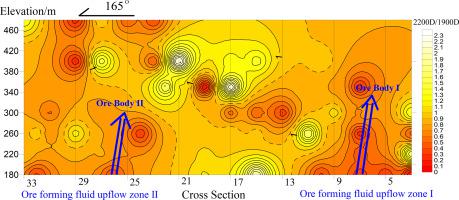Journal of Geochemical Exploration ( IF 3.4 ) Pub Date : 2021-06-07 , DOI: 10.1016/j.gexplo.2021.106833 Yuzeng Yao , Yuanchu Zhu , Jiacheng Liu , Weiqun Li

|
Most hydrothermal ore deposits have experienced multiple stages of hydrothermal activities and the overprinting makes the footprints of ore fluid pathway difficult to identify, which prevents us from targeting the mineral resource effectively. In this paper, the altered wall-rocks from all accessible underground tunnels of No.101 lode in the Shihu Gold Deposit, North China were investigated by the combined methods of petrographic microscopy and short wave infrared spectroscopy (SWIR). The results show that there are three types of alteration in the Shihu Gold Deposit, i.e., the proximal illitic alteration, the transitional chloritic alteration and the distal propylitic alteration. The wavelength (wvl) of the 2200 nm absorption features (2200wvl) of the illitic alteration rocks around ore bodies are shorter than those from the barren areas, suggestive of the compositional variation of illites derived from the multiple stages of hydrothermal fluids. The domains with higher absorption depth at 1400 nm, 1900 nm and 2200 nm (1400D, 1900D and 2200D) are spatially coincident with the economic ore bodies, which is well in accordance with the field truth that the gold mineralization in the Shihu mining district is intimately related to illitic alteration. The band ratio of 2200D/1900D, which is regarded as the proxy to illite crystallinity, is positively related to the temperature of fluid inclusions. The coincidence between low crystallinity and gold mineralization reflects the fact that fluid temperature during the main mineralization stage was relatively low compared to those of previous stages. Detailed investigation indicated that the economic ore bodies mainly occurred in the structural dilation domains, i.e., the widened portions of the ore-controlling structure were more suitable for the fluids migration and probably acted as the fluid up-flow zones. Therefore, SWIR spectroscopy of illite is a powerful tool to trace the ore fluid pathway, which is crucial to the understanding and exploration of gold mineralization.
Based on the geological significance of the SWIR signatures and the investigation of the ore-forming conditions, it can be concluded that there are two fluid up-flow zones in No.101 lode, one of which lies on the north of No.13 cross section and centered at No.7 cross section, whereas the other on the south of No.17 cross section and centered at No.27 cross section. As a result, two steeply dipped ore bodies were formed along the up-flow zones. According to this ore-forming analysis, the location centered at No.47 cross section with elevation below 150 m would be an ideal site for the formation of a third ore body. This has recently been verified by underground drillings in the Shihu Gold Deposit (Yougang Zhang, pers. commun. 2020).
中文翻译:

华北石湖金矿床矿流体路径足迹及其对矿产勘探的影响:来自伊利石蚀变岩短波红外光谱的证据
大多数热液矿床都经历了多个阶段的热液活动,叠印使得矿石流体路径的足迹难以识别,阻碍了我们对矿产资源的有效定位。【摘要】:采用岩相显微镜和短波红外光谱(SWIR)相结合的方法,对华北石湖金矿101矿脉所有可接近地下隧道的蚀变围岩进行了研究。结果表明,石湖金矿床存在近端伊利石蚀变、过渡绿泥质蚀变和远端青绿岩蚀变三种蚀变类型。矿体周围伊利石蚀变岩2200 nm吸收特征(2200wvl)的波长(wvl)比贫瘠地区短,表明来自多阶段热液流体的伊利石的成分变化。1400 nm、1900 nm和2200 nm(1400D、1900D和2200D)吸收深度较高的域与经济矿体在空间上重合,这与石湖矿区金矿化的现场实况非常吻合。与非法改造密切相关。2200D/1900D 的带比被视为伊利石结晶度的代表,与流体包裹体的温度呈正相关。低结晶度与金矿化的重合反映了主矿化阶段流体温度与前几个阶段相比相对较低的事实。详细调查表明,经济矿体主要分布在构造扩张域,即控矿构造的加宽部分更适合流体运移,可能作为流体上流带。因此,伊利石的短波红外光谱是追踪矿石流体路径的有力工具,对金矿化的认识和勘探至关重要。
根据短波红外特征的地质意义和成矿条件调查,101矿脉中存在2条流体上流带,其中1条位于13号交叉口以北。断面以7号断面为中心,另一个在17号断面以南,以27号断面为中心。结果,沿上流带形成了两个陡倾矿体。根据该成矿分析,以47号断面为中心,海拔低于150 m的位置将是第三矿体形成的理想地点。最近在石湖金矿床的地下钻探证实了这一点(Yougang Zhang, pers.commun. 2020)。











































 京公网安备 11010802027423号
京公网安备 11010802027423号